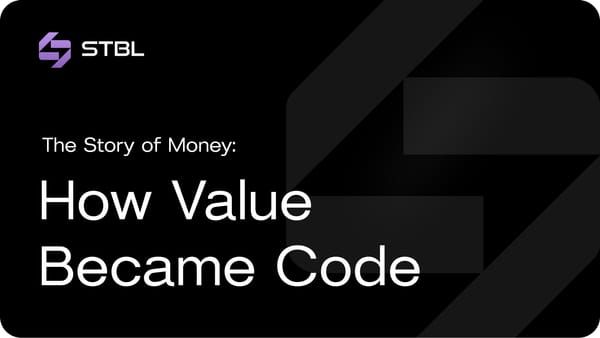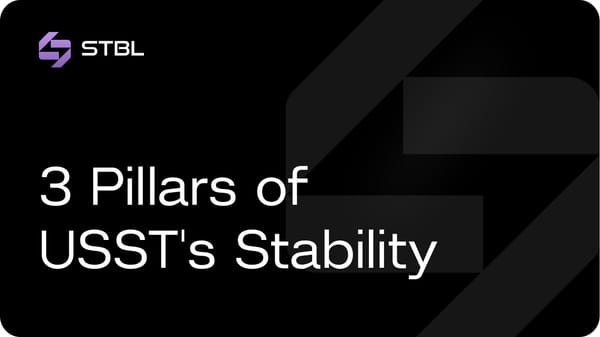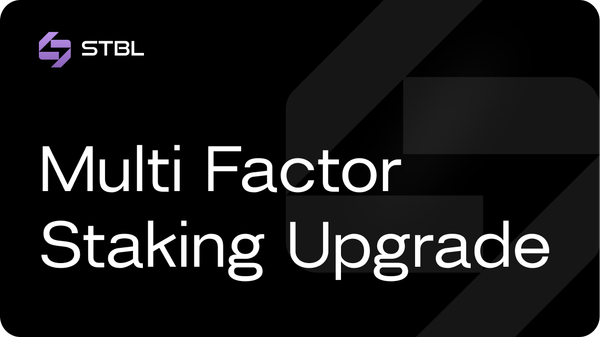STBL <> KAITO Creator Guide

1. Purpose and Scope
This document provides creators with up-to-date, approved information about STBL, its products, strategy, partnerships, and public materials. Use this document as the single source of truth when producing content about STBL for social media, blogs, video, or other channels.
2. Executive overview
The future of money is programmable, composable, and tailored to specific ecosystems. STBL is the foundational infrastructure for Ecosystem Specific Stablecoins (ESS), providing the payment rails that allow governments, sovereigns, corporations, and large ecosystems to issue branded, interoperable stable-assets without building custom infrastructure from scratch.
Built on the principle of Stablecoin 2.0, STBL bridges real-world assets (RWAs) and decentralized finance through a transparent, on-chain framework. By separating principal and yield, STBL enables ecosystems, institutions, and users to design stablecoins that are directly backed by tokenized RWAs, combining the stability of traditional assets with the composability of modern blockchain infrastructure. This structure aligns with diverse liquidity, compliance, and yield objectives while maintaining full on-chain auditability.
The protocol’s core architecture consists of three coordinated assets:
- USST, a universal stablecoin fully backed by tokenized real-world assets. USST provides the principal liquidity layer and serves as the common settlement unit across ESS issuers.
- YLD, a tokenized representation of the yield generated by RWA collateral. YLD makes the yield stream a tradable, allocable instrument separate from spendable principal.
- $STBL, the governance, coordination, and value participation token. $STBL holders set protocol parameters, guide ESS policy, and participate in value created by adoption and network activity.
ESS enables any ecosystem, government, or institution to issue its own stablecoin, governed by configurable vault rules and fully interoperable with the universal USST layer. Examples of potential ESS issuers include governments, payment networks, and large platforms that may issue branded stablecoins while retaining the ability to swap into USST for global liquidity.
STBL emphasizes transparency, verifiable collateralization, and community-aligned value capture through governance.
STBL Buyback Initiative
STBL has initiated a structured buyback program, beginning with a $1 million execution (Part 1) via a Time-Weighted Average Price (TWAP) strategy on the PancakeSwap STBL/USDC pool. Repurchased tokens are transferred and manually locked in a publicly visible Buyback Treasury Vault for on-chain verification:
0xB3dd2BF3bE5B53D3e1E8c863DebB36450DC553bc
This buyback reflects the protocol’s confidence in its fundamentals and commitment to transparency. Future buybacks will be protocol-funded and will scale dynamically with network activity (USST TVL, market valuation, and governance decisions). This framework establishes the foundation of STBL’s value loop, reinforcing long-term sustainability and community alignment.
The Multi-Factor Staking (MFS) module complements this value loop by encouraging active network participation and liquidity commitment. Users can stake $STBL or a combination of $STBL and $USST to earn $STBL rewards, with incentives that adjust based on participation parameters such as stake composition and overall ecosystem activity.
MFS channels staking activity back into the protocol’s economic cycle, helping deepen liquidity, reduce circulating supply, and strengthen long-term alignment between users and the STBL ecosystem.
Through its integration of RWAs, on-chain transparency, and institutional-grade architecture, STBL transforms stablecoins from single-purpose instruments into a programmable monetary layer that supports composable finance, sovereign and corporate issuers, and transparent, yield-sharing economic models.
3. Core Products and Narratives
Product Definitions
USST
A universal stablecoin backed by tokenized real-world assets (RWAs).
USST provides stable liquidity across DeFi and institutional ecosystems, serving as the foundation for programmable stability.
It represents the “principal” component in STBL’s split design, where yield is separated from capital to enable transparency and flexibility.
YLD
A tokenized representation of the yield generated by RWA collateral.
YLD separates the right to returns from the underlying stable asset, allowing users and institutions to hold, trade, or allocate yield independently.
This design establishes capital efficiency — liquidity remains stable in USST, while yield accrues through YLD.
$STBL
The governance, coordination, and value participation token of the ecosystem.
$STBL holders govern the protocol, vote on ecosystem parameters, and participate in the long-term value created as stablecoin adoption expands across ESS vaults and integrations.
A structured buyback program has commenced with a $1 million execution (Part 1) via TWAP on the PancakeSwap STBL/USDC pool. All repurchased tokens are locked in a public Buyback Treasury Vault (0xB3dd2BF3bE5B53D3e1E8c863DebB36450DC553bc) for transparency.
Over time, buybacks will transition to a protocol-funded mechanism and scale dynamically with network activity and governance, ensuring that token value reflects genuine adoption and participation.
ESS (Ecosystem Specific Stablecoins)
A framework that enables governments, institutions, and large ecosystems to create their own stablecoins anchored to USST.
Each ESS vault defines its own collateral baskets, issuance rules, and yield management parameters, allowing for customizable compliance and monetary design.
ESS connects traditional financial assets to on-chain programmable money, enabling both regulatory flexibility and composable liquidity.
Examples of potential ESS issuers include governments, payment networks such as Visa or Mastercard, and large digital platforms like Bolt, each able to launch their own branded stablecoin powered by USST and governed by the ESS framework.
(These names are examples only and not official partnerships.)
MFS (Multi-Factor Staking)
A staking module that encourages active participation and liquidity commitment within the STBL ecosystem.
Users can stake $STBL or a combination of $STBL and $USST to earn $STBL rewards, with incentives that adjust based on participation factors such as stake composition and overall ecosystem activity.
MFS reinforces the protocol’s deflationary model by aligning staking activity with the broader buyback-and-burn cycle and supporting long-term liquidity stability.
STBLverse
STBLverse represents the ecosystem’s first large-scale community engagement initiative, an interactive airdrop and reward program for early users and creators.
It will serve as the gateway to deeper participation in the STBL ecosystem and its products.
STBLverse and related details will be announced soon.
Core Narrative and Talking Points
- 6Stablecoin 2.0: Separation of Principal and Yield
STBL introduces a new RWA-backed stablecoin architecture where liquidity (principal) and yield are split into independent, programmable components, enabling transparency and flexibility for both retail and institutional users.
- Customizable Yield and Stable Liquidity
Through the ESS framework and Multi-Factor Staking, users can configure how their stable assets perform, managing yield exposure and stability preferences with full transparency.
- Real-World Asset Collateralization
STBL connects tokenized real-world assets (T-bills, money markets, private credit, etc.) to DeFi infrastructure, creating an auditable bridge between traditional finance and on-chain stability.
- Community-Aligned Value Capture
Unlike legacy stablecoins where issuers retain yield, STBL distributes economic value to vaults and ecosystems through on-chain mechanisms, aligning incentives across the system.
- Sustainable Value Accrual and Buyback MechanismSTBL’s value loop is reinforced by a structured buyback program, initiated with a $1 million TWAP execution on PancakeSwap. Repurchased tokens are locked in a public vault for transparency, and future buybacks will be protocol-funded and scale with network activity and governance.
- Ecosystem Specific Stablecoins (ESS): Programmable Stability
ESS allows any government, institution, or ecosystem to issue its own stablecoin anchored to USST and governed by its own vault rules. This enables branded, interoperable stablecoins, for example, a Government Stable, Visa Stable, Mastercard Stable, or Bolt Stable, all powered by USST.
These examples illustrate the flexibility of the ESS framework and are not official partnerships
4. Key Links and Official Channels
Use these links for verification and to reference canonical content.
Partnership summary (public):
- $100M USST minting partnership led by Wave and Franklin Templeton, using institutional-grade collateral such as USDY, iBenji, and BlackRock’s BUIDL.
- $50M Ondo Finance USST minting partnership (see tweet).
5. Founders and Leadership
Reeve Collins
Chairman and Co-founder, STBL
Reeve Collins is a founder and entrepreneur in digital assets and programmable assets. He co-founded Tether and served as CEO, scaling its impact on on-chain liquidity and settlement. He founded BLOCKv and Smart Media Technologies and has led multiple products that bridge traditional finance and blockchain. At STBL, Reeve focuses on strategy and ecosystem partnerships to advance Stablecoin 2.0 and ESS.
X: https://x.com/Reeve_Collins
Dr. Avtar Sehra
CEO and Co-founder, STBL
Dr. Avtar Sehra holds a PhD in theoretical physics and has led institutions and products that tokenize financial assets. He founded KAIO (formerly Libre Capital) and Nivaura and has worked on institutional asset tokenization and compliant infrastructure. At STBL, Avtar leads product engineering and the ESS strategy, connecting RWAs with DeFi in a compliant, auditable manner.
6. Public Partnerships and Proof Points
Only reference partners and commitments that are public. Approved examples:
- $100M USST minting partnership led by Wave and Franklin Templeton, leveraging USDY, iBenji, and BlackRock BUIDL.
- $50M USST minting capacity partnership with Ondo Finance (see official tweet).
- Audit by Cyfrin available publicly.
Do not disclose or reference any non-public partnerships or negotiations.
7. Token Listings and Market References
Approved listing pages:
Guidelines for creators:
- Link to official listing pages only.
- Do not speculate about future listings or timing.
- Do not offer trading or investment advice.
- Avoid implying guaranteed outcomes or price projections.
8. What Content will Not be Rewarded
Creators will not receive rewards or recognition for content that includes:
- AI-generated filler or repetitive content.
- Unverified or inaccurate claims about the project, token supply, or team.
- FUD-inducing posts or rumor amplification.
- Financial speculation or “price prediction” content.
- Leaked or confidential information.
- Copy-paste press releases without commentary.
- Recycled content without unique contribution or insight.
- Content that describes the buyback as a “burn” or implies guaranteed price outcomes.
- Claims about fixed, recurring buyback amounts or schedules not stated in official materials.
9. Creator Do’s and Don’ts
Do:
- Use official links for all references.
- Verify claims before publishing.
- Focus on technology, design, and verified partnerships.
- Ask the marketing team for clarification when uncertain.
Don’t:
- Promise returns or use investment language.
- Speculate on private details or token price.
- Publish unverified or misleading comparisons.
- Use sensationalist language or memes implying financial outcomes.
10. Compliance and Sensitive Language Checklist
Before publishing content, confirm:
- No financial or trading advice is implied.
- No references to unannounced partnerships or listings.
- No yield, income, or profit promises.
- All audits and product links reference official documents.
When in doubt, consult the compliance or communications lead before posting.
11. Templates and Content Inspiration
Some examples of good content pieces:
- https://x.com/dor_alpha/status/1980197220172669028
- https://x.com/bonsai_Traveler/status/1980591906716569992
- https://x.com/Karamata2_2/status/1973773133468557728
- https://x.com/Karamata2_2/status/1978755045417193916
- https://x.com/thehiddenmaze/status/1976702315319984401
- https://x.com/btfdmoney/status/1976670837345591509
- https://x.com/belizardd/status/1974790636600766709
12. Resources and Assets
13. Version Control and Updates
This document is the canonical creator guidance for STBL. It will be updated as milestones evolve. Check this page before publishing any campaign-related content.
Current document version: v1.4
Last updated: 03 Nov 2025




